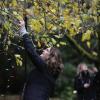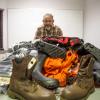April 30, 1998 - 5:00pm
A class project for an applied anthropology class turned into the experience of a lifetime for Jane Saxton, a fourth year student and employee at Malaspina University-College.
As one of her class assignments, Saxton wrote a proposal to promote the use of solar cooking in high altitude villages in Nepal. Six months later, this adventurous mother of two was hiking the Himalayas, teaching villagers how to use a unique solar cooker she designed herself.
The trip fulfilled one of Saxton's lifelong dreams. "I've always wanted to trek through the Annapurna Range in Nepal," she says. "It was an incredible and unforgettable experience. I still get goose bumps talking about it."
Saxton has worked full-time at Malaspina since 1982 and enrolled in her first anthropology class 10 years ago.
"After that, I was hooked. I've been taking one or two classes per semester ever since," she says. "Next year, I'll have my degree."
It was during an applied anthropology class when Saxton first began thinking about the use of solar cookers in Nepal.
"We had to write a proposal for a development project," she recalls. "I've always been fascinated with Nepal and knew right away that's where my project would be located. My instructor suggested I look into solar cookers, so I did."
Saxton spent two and a half months researching Nepal's environmental conditions and culture. She discovered that conditions in the mountainous regions are rapidly deteriorating because of the country's burgeoning population. Also, the phenomenal number of trekkers in recent years is resulting in serious degradation of the environment.
"Villagers, mainly women, are spending an incredible amount of time cutting down trees and pulling up shrubs off the steep mountain slopes in order to provide fuel to cook hot meals for their families and the trekkers," Saxton says. "As a result, the soil on the mountainsides is becoming more and more unstable. As trees are cut down, village women are having to go farther and farther into the mountains to collect fuel wood, away from their families and agricultural chores close to home."
Saxton knew solar cookers could be a viable alternative for the village women, but the device needed to be simple, low cost and easy to use - something that did not require parts. "It also had to relieve the drudgery of these women's lives."
Through the library and internet, and leads provided by her instructor, Saxton contacted an organization called Solar Cookers International in Sacramento, California, which sent her information on the use of solar cookers all over the world. She prepared her proposal, complete with detailed diagrams of various types of solar cookers that could be used in high altitude regions.
As soon as the proposal was complete, Saxton knew she wanted more than just an A for her course.
"I wanted to follow through with it - I wanted to travel to Nepal and work with women in the developing world. My goal was to use a participatory model to help these women use their own knowledge to build solar cookers and use solar energy."
Saxton phoned, faxed and wrote to every contact she could think of, including several non-governmental organizations that perform development work worldwide.
"I networked like crazy," she says. "I wanted to find support in Katmandu, the capital city of Nepal. The response was overwhelming."
She traveled to Jordan and worked for six weeks in an archeological field school at a 3,000 year old iron age site.
After that amazing experience, Saxton traveled to Syria and then India. By mid-September, she arrived in Katmandu, Nepal where she joined the Centre for Rural Technology - a small group of technicians and anthropologists who worked in rural communities to respond to villagers' needs with appropriate low-impact technologies.
"They had two types of solar cookers in their office," recalls Saxton, "one was a parabolic reflector, which was big, awkward and dangerous to use, and the other was a flimsy box cooker made out of cardboard."
One day, Saxton strolled through a village market and spotted several baskets woven by local women. "That gave me an idea," she says. "I bought a few baskets and began experimenting." Eventually, she designed a basket solar cooker "that worked like a hot damn."
Saxton lined a large basket with plastic sheeting as a wind barrier and insulated it with cotton batting. She placed a smaller basket inside, which acted as the oven. A sheet of light-weight metal painted flat black was placed at the bottom of the inner basket to absorb heat. Then, a black cooking pot was placed inside.
She glued aluminum foil to the inside of a flat basket, and lashed this "lid" to the large basket. Using polyester and a bamboo rim, she also made a tight fitting lid for the inner basket.
"The sun reflects on the aluminum foil and is directed to the black pot inside the inner basket," she explains. "In our trial experiments, we cooked rice, stew, vegetables, apple sauce, lentils and porridge - all the traditional foods of Nepalese villagers."
With the new basket solar cooker design perfected, Saxton was ready to hit the mountains. The Centre for Rural Technology put her in touch with an Agricultural Women's Project working in mid-mountain altitude regions of Nepal.
"Three of us trekked straight up the mountainside, 78 kilometres from Katmandu, to meet with the villagers and demonstrate the solar cooker," recalls Saxton.
"The Coordinator for the Women's Project was fantastic. She spoke English and was devoting her life to helping make life easier for rural women in the mountains."
Saxton sat down at a village meeting under a huge tree in the school yard, demonstrating how to use the solar cooker.
"I cooked a pot of rice, which took one and a half hours," says Saxton. "The villagers - especially the women - were thrilled. They could not believe that the energy from the sun could cook food."
Through a translator, Saxton discussed with the women ways to build their own basket solar cookers using available materials. The women already wove baskets, so they discussed how to make their own glue out of buckwheat flour and water, and how they could use scraps of fabric, yak wool or corn husks for insulating the baskets.
A week later, Saxton returned to her home base in Katmandu, but yearned to work on a project even higher in the mountains. One of the technicians at the Centre was flying into villages in the high-altitude region of Nepal, and agreed to take along materials and supplies to build 20 solar cookers. He took string, foil, light weight metal sheeting and a handful of cheap thermometers.
"I didn't know if I would run into him in the mountains or not, but that was the only way I could get the supplies up there," Saxton says.
Armed with a three week trekking permit from the Nepalese government, Saxton hired a Sherpa (guide) to lead her on foot into the mountains. "He was an 18-year old boy named Karma," recalls Saxton. "The day we were supposed to leave, he showed up in thongs, shorts and with no sweater or sunglasses. I had to completely outfit him before we left. Later I discovered that he couldn't speak English or read maps."
Saxton and the Sherpa trekked for 10 days through the rugged and spectacular Annapurna Range. "It was magnificent," she says.
When they arrived at the village of Braga, she was amazed to see a sign that read "solar showers."
"I was so excited - obviously someone in this tiny village knew about the power of solar energy."
When Saxton checked into the guest house, she saw the technician from the Centre walking down the trail. "It was unbelievable," she says. "There he was, followed by a porter carrying all my supplies for making solar cookers. It was serendipitous."
Within days, Saxton was leading another demonstration for the villagers, cooking potatoes with her solar cooker. Once again, the villagers were thrilled and excited at the sight of this alternative method of cooking.
Saxton and the villagers discussed how solar cookers can also be used to warm icy river water for bathing and to pasteurize drinking water.
"While working with these women they came to me and said they had a problem with weevils and bugs in their stored grain. We brainstormed how the solar cooker could be used to kill the bugs."
She also spent a few days at a Buddhist convent, above the village, demonstrating solar cooking to the nuns.
"When I went back to Katmandu, I continued to work on a solar dryer - a flat basket - which women could use to kill bugs in their grain."
Since returning to Canada, she has had no contact with the villagers she worked with in Nepal because they are illiterate. "I think about them often and definitely plan to return."
Saxton regularly uses a solar cooker herself at her cabin on DeCourcy Island to bake bread and muffins, and cook chili. In the meantime, she continues studying towards her degree, dreaming about the day she can return to the tiny, mountainous villages in Nepal.
Tags: In the Community






